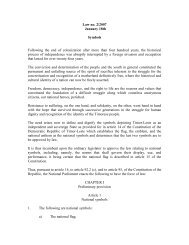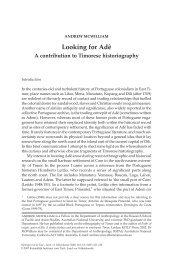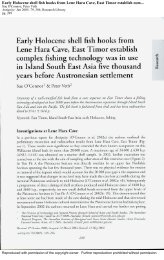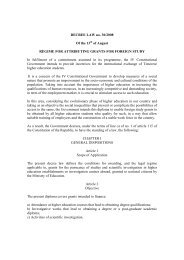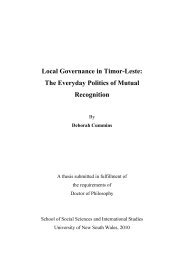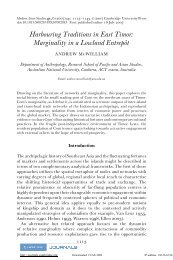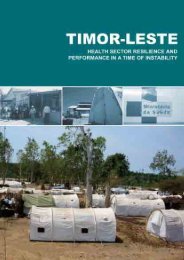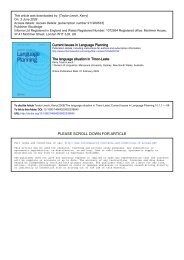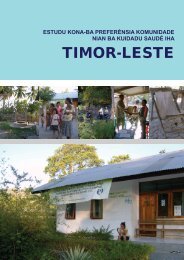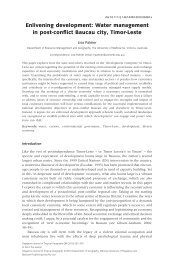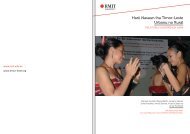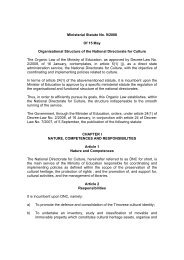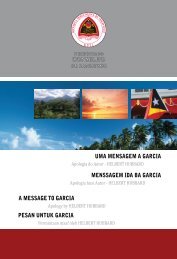Timor-Leste Health Care Seeking Behaviour Study - Secretaria de ...
Timor-Leste Health Care Seeking Behaviour Study - Secretaria de ...
Timor-Leste Health Care Seeking Behaviour Study - Secretaria de ...
- No tags were found...
You also want an ePaper? Increase the reach of your titles
YUMPU automatically turns print PDFs into web optimized ePapers that Google loves.
efer to the baby’s willingness to be <strong>de</strong>livered or not, resulting in prolonged and difficult, orunproblematic labour.For an unproblematic birth at home, a woman may or may not call a TBA to assist. Many informantsused the term ‘trained TBA’ (dukun terlatih) to distinguish those TBAs provi<strong>de</strong>d with training andresourced during the Indonesian period from those TBAs who have never been trained. Several saidthat TBAs are able to <strong>de</strong>termine an incorrect (antenatal) position of a baby mentioned as ‘lyingwrong’ (toba salah), and re-position or turn (fila) the baby manually by ‘holding and pushing’ (dudukaer) or, during labour, by ‘holding the si<strong>de</strong>s of the stomach and pushing down to correct’ (kaer husikabun sorin dudu tun no halo los) (see Box 9).A few informants (and several government health provi<strong>de</strong>rs) mentioned infection resulting from theTBA cutting and tying the umbilical cord.Informants <strong>de</strong>scribed various actions taken within the household in the event of difficult birth. Theseinclu<strong>de</strong>d applying hot compresses, giving hot water to drink, elevating the woman’s legs by tyingthem up with cord to reduce bleeding, giving traditional medicine (e.g. certain leaves knea<strong>de</strong>d(dulas) into a ball and applied to the stomach), providing a bottle into which the woman could exhaleor blow, and suspending a rope from the ceiling by which the woman could support herself. (Manyof these household-level actions are probably taken also for births consi<strong>de</strong>red to be unproblematic.)A TBA may be called to assist a difficult birth when the labour takes place during the night, when thehealth facility is far and there is no transport, or when the road to the health facility is cut by floodingduring the wet season. Difficulties mentioned for which a TBA could not assist, and for whichexhaustive efforts were then taken, sometimes unsuccessfully, by family members to call a midwifeto the house or transport the woman to a health facility inclu<strong>de</strong>d haemorrhage, baby’s arm or legfirst, long labour, retained placenta, woman has no energy to push, and excessively large baby. Helpwas also sought from midwives if waters broke early or labour began prematurely. One married manobserved that, in the context of a difficult birth, the doctors (i.e. health workers) “know what isinsi<strong>de</strong>, we can only see outsi<strong>de</strong>”. 13Informants mentioned almost 30 forms of difficult birth, with the most common being retainedplacenta, baby’s arm or leg <strong>de</strong>livers first, long labour, position of baby, twins and stillbirth. Otherdifficulties inclu<strong>de</strong>d those related to the mother (first birth, very young mother, old mother) andthose occurring in the pregnancy (e.g. spontaneous miscarriage, premature labour or early ruptureof membranes, anaemia and heart-condition). Problems arising during <strong>de</strong>livery inclu<strong>de</strong>d blue baby,mother breathless (iis la to'o) and/or too weak to push, excessively large baby and/or large head,arms and legs of woman without strength (mamar), placenta <strong>de</strong>livers first, or ‘white blood’ (raanmutin)—fainting or light-hea<strong>de</strong>dness or swelling to the eyes believed to result from the womanbecoming cold after <strong>de</strong>livery and white blood rising to the head. Raan mutin is usually treated with ahot compress or warmed palm wine/tuak to drink. Problems following <strong>de</strong>livery inclu<strong>de</strong>d infection asa result of cutting and tying the umbilical cord, postpartum haemorrhage, and malaria in thenewborn.Several advantages of calling a midwife to assist a difficult labour, or <strong>de</strong>livering in a health facility,were mentioned. It was said that a health provi<strong>de</strong>r (unlike a TBA) could advise the right time to13 ‘Tamba inan isin rua ne’e ita hare <strong>de</strong>it husi liur maibe laran ne’e ita la hatene lolos doctor sira mak hatene nebe lori ba ihadoctor sira hodi koko’ (Married man, FGD, Manututu).38<strong>Timor</strong>-<strong>Leste</strong> <strong>Health</strong> <strong>Care</strong> <strong>Seeking</strong> <strong>Behaviour</strong> <strong>Study</strong> | 2009



